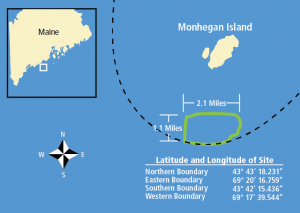Site Selection
The test site south of Monhegan Island was selected following an extensive public outreach process conducted by the State of Maine due to its distance from the mainland, strong and consistent winds, limited number of fishermen, and close proximity to an island with high energy costs. More than five years of ecological and environmental surveys have been conducted, making the test site one of the most extensively studied locations in the Gulf of Maine. Any future commercial-scale projects involving UMaine’s VolturnUS technology will be sited at least 10 miles from any island, peninsula, or mainland.

Test Site Selection
In 2008, Governor John Baldacci established Maine Ocean Energy Task Force to recommend a strategy to develop the renewable ocean energy resources in the Gulf of Maine. Click here to view the Ocean Energy Task Force Final Report, published in December 2009. This report set Maine’s renewable ocean energy goals, including the installation of 5 GW (5,000 megawatts) of offshore wind energy by 2030.
In 2009, the Maine Department of Conservation (DOC) designated the site off Mohegan Island as one of three wind energy test areas off the Maine coast.
These sites were chosen through extensive analysis and outreach efforts by State officials, with input from local/federal officials, fishermen, and residents, to examine the Maine coast for the best possible test site with least amount of impact.
As part of this process, a community forum was held on Monhegan Island to discuss issues related to the identifying a wind energy demonstration area off of Monhegan. During this forum, fishermen were asked to engage in a mapping exercise to rank blocks within the planning area to understand if and where a wind energy demonstration project could be located in waters near to the Island. Several Monhegan fishermen submitted rankings to the State Planning Office as part of this outreach process.
As a result of this outreach process, the DOC also designated Monhegan as the Maine Deepwater Offshore Wind Test Site (shown above) to support UMaine’s ongoing research and development efforts.
Since 2009, UMaine has continued its outreach with Mohegan and Midcoast Maine and other potentially affected industry and environmental stakeholders. With dozens of meetings, presentations, video conferences, and telephone conferences, as well as more than two years of calls with the Monhegan Energy Task Force (METF), UMaine has demonstrated its ongoing commitment to the island’s concerns.
In July 2016, Monhegan Island voted to engage in negotiations with Maine Aqua Ventus on a community benefit package, a significant milestone and requirement of the project’s power purchase contract term sheet with the Maine Public Utilities Commission.
Working alongside the Monhegan Island community since 2009
Since 2009, UMaine has continued its outreach with Monhegan and Midcoast Maine and other potentially affected industry and environmental stakeholders. With more than 250 meetings, presentations, video conferences, and telephone conferences since 2009, as well as more than three years of weekly or monthly calls with the Monhegan Energy Task Force (METF) since its inception, UMaine has demonstrated its ongoing commitment to the island’s concerns.
The UMaine Deepwater Offshore Wind Test Site was selected with input from local fishermen, and Maine Aqua Ventus (MAV) is committed to local economic opportunities for island fishermen and vessels whenever possible.
In July 2016, Monhegan Island voted for the Monhegan Plantation to engage in negotiations with MAV on a community benefit package, a significant milestone and a requirement of the project’s power purchase term sheet with the Maine Public Utilities Commission.
UMaine’s Commitment to Island and Coastal Communities
UMaine is committed to responsible offshore development in a manner that includes involvement and guidance by local communities and marine users. UMaine understands the economic and cultural significance of our coastal and island communities and neighboring waters. Our measured and informed approach to offshore wind development is intended to minimize potential risks or adverse effects on existing industries and the natural environment.
UMaine is committed to:
- Frequent outreach with communities and existing marine users
- A single-turbine demonstration project within the University of Maine Deepwater Offshore Wind Test Site at Monhegan Island for evaluating technology, monitoring the environment, and developing best practices for coexistence with marine users
- An emphasis on local economic development opportunities
- Future use of UMaine’s VolturnUS floating technology only in commercial projects located more than 10 miles from Monhegan, other inhabited Maine islands, and the mainland coast.
What studies have been done at the test site? Will more studies be done?
From 2011 to present, the University of Maine, the State of Maine, and U.S. Department of Energy funded significant efforts to characterize the baseline physical and ecological environment of the test site, including: metocean conditions; bird and bat studies; fish, lobsters, marine mammals; cultural/historical; and geophysical surveys. No other location in the Gulf of Maine has been studied this extensively.
The full list of completed surveys and results can be viewed at: https://umaine.edu/offshorewindtestsite
What activities are allowed in the test site?
The UMaine Deepwater Offshore Wind Test Site can be used for offshore wind energy demonstration projects conducted by or in cooperation with the University of Maine. The law limits usage for windpower generation to a maximum of 2 wind turbines and one submerged utility line sized for the pilot project.
Where can I find additional resources?
For additional resources, such as the final report of the Ocean Energy Task Force, a letter from the State of Maine Department of Conservation that explains the test site process and designation, relevant legislation, or results of ecological surveys and related studies, please visit: https://umaine.edu/offshorewindtestsite
